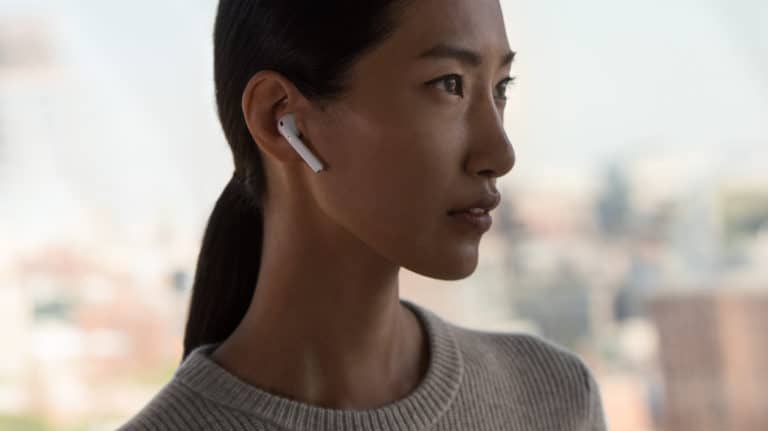
We often joke that the original form of AR was radio. It augments your perception of the world while driving, jogging, etc.. While meant in jest, this raises an important point about expanding our conceptual understanding of augmentation.
Sound could very well be a more viable near-term AR modality. “Audio AR” as we call it, could come sooner than—and eventually coexist with—its graphical cousin. This point of convergence is where Apple is headed with a range of wearables that will eventually include glasses.
One possibility is what Charlie Fink posited in a great AWE Europe presentation: a subtle lapel camera, which feeds sensory data to the AR audio device in your ear. You can imagine potential killer apps that build on this form factor, and that sidestep AR glasses’ style crimes.
Think of the possibilities with contact-based applications that tell you valuable background info on someone you’re about to have lunch with, or with whom you’re shaking hands at a conference. This turns us all into secret service agents, armed with a subtle whisper of intel on the fly.

Order of Operations
As for how it plays out, the hardware installed base first needs to be established, and user behavior has to be conditioned for an all-day wearable. We’re already halfway there if you consider Apple has conditioned users with its most successful product in years: Airpods.
We’re calling this device category “hearables,” and there were 24 million Airpods sold in 2018 according to Juniper. As always, Apple’s lead will be followed by hardware commoditization by third parties, and falling hardware component costs that engender ubiquitous penetration.
Then it’s all about the apps and use cases that develop. Apple could be disadvantaged, given that its AI engine for audio content is the laughably inept Siri. Here, Google has the edge with the superior Google Assistant, and it’s already making moves towards Audio AR with its Pixel Buds.
The latter’s use cases so far include live foreign language translation. Think of the in-ear translation devices used by U.N. delegates—but for the rest of us. Other apps will develop around commuting, dating, or the corporate use case outlined above, developed by LinkedIn.
![]()
Eyes & Ears
This app development will be a key step, when third-party developers could really run with Audio AR by building apps on SDKs released by Apple or Google. This follows the playbook already established by iOS and Android. Audio AR could even branch ARkit and ARCore.
Driving and walking directions, à la Google’s VPS, are a logical starting point just as they are with graphical AR. That then extends to all kinds of commerce and monetization opportunities with consumer brands. Whisper a subtle alert in my ear whenever I’m near an In-n-Out Burger.
There are lots of directions it could go. But the foundational principle is that we’ll all become empowered through audio whispers, thus augmenting our realities. And it’s already unfolding in interesting and native ways, foreshadowed this week by Ubiquity 6’s acquisition of Wavy.
Just as graphical AR evolves with context-aware and intelligent information layers (image persistence, occlusion), audio AR will get more dimensional and textured. It could even develop alongside graphical AR, and benefit from enablers like the AR cloud. We’ll be watching closely.
For deeper XR data and intelligence, join ARtillery PRO and subscribe to the free AR Insider Weekly newsletter.
Disclosure: AR Insider has no financial stake in the companies mentioned in this post, nor received payment for its production. Disclosure and ethics policy can be seen here.
Header image credit: Apple
